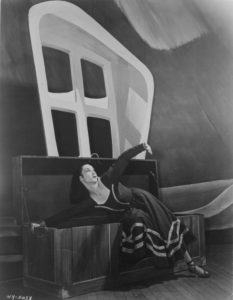
By Rebecca Karpus
The young protagonist moves into a new home in an unfamiliar country to begin married life. She is lonely, and becomes overwhelmed by the harsh climate, isolated locality and barren landscape. Overcome by dark feelings, she reaches her breaking point.

While this could sound like a contemporary drama, it is actually the plot of Gweneth Lloyd’s 1952 Royal Winnipeg Ballet production, Shadow on the Prairie. Amy Bowring, who teaches dance history at Toronto’s Ryerson University, explains that if you position it contextually, the ballet’s story can be seen not only as meaningful for its time, but also as significant today. Considering that Canadian cultural nationalism was on the rise when the ballet premiered, Lloyd’s sobering take on an immigrant experience was a daring one, and its theme of survival is a typical Canadian literary trope.
This example of how connections between dance, art and society can illuminate historic work from multiple perspectives, and bring dance history to life in timely ways, is one approach to building a relevant undergraduate curriculum. Bowring, who is the executive and curatorial director at Dance Collection Danse, a national archives and publisher in Toronto, specializes in Canadian dance history. She understands that every specific locale brings something unique to the landscape of dance history: art is directly impacted by its environment.
Alison D’Amato, an assistant professor at University of Southern California’s Glorya Kaufman School of Dance, sees validity in the popular approach of dance history pedagogy characterized by clean categorization into eras and “isms” (such as romanticism and modernism), but her own focus is to “put the body at the centre of history making.” When using this perspective, history springs into action as actual people and places, giving students something tangible to grab onto. Once a student is able to make connections between historical events and their creators, they can start to notice things like bias and subjectivity in the record-keeping.

Because of this, D’Amato teaches her students that history can be considered a constructed narrative and she urges them to interpret historical records with a critical eye. When she builds her courses, she attempts to “seek out the scholarship that might illuminate some of the voices and faces that were at certain points written out of history.” In an effort to challenge this erasure, she believes it is vital for today’s dance history education to address “the way history connects to power and visibility.”
Henry Daniel, a professor at Vancouver’s School for the Contemporary Arts at Simon Fraser University, also pushes students to see past what is obvious at first glance by asking, “Whose history are we talking about?” For example, he might discuss Arthur Mitchell, founder of Dance Theatre of Harlem, in relation to Russian-American choreographer George Balanchine. In 1955, Mitchell became the first Black dancer with Balanchine’s company, New York City Ballet, and Daniel believes that it is not only important to recognize Mitchell’s presence in a predominantly white space like NYCB, but also to address his influence on Balanchine’s choreography. “Choreographers are [always] drawing on the bodies they are working with,” Daniel says.
In this way, students can work through issues of visibility and inclusion. Another way he achieves this is by offering provocative essay prompts such as: “The history of dance is no more than the regurgitation of a few North American and European names — discuss.” The intention is to help move students beyond the predominant voices in dance history, hoping they will discover something novel and meaningful to them through their research.

At the end of the day, one of the most essential ingredients to a successful dance history education is the ability to captivate each student on an individual level. Daniel inspires his students to “claim” some part of dance history by asking them, “How do you see yourself as a part of this history?” He reminds them that by practicing a certain dance technique, one becomes an active participant in the “unfolding” of that technique. It is also a meaningful way to connect to those who have come before you, Daniel says, by trying to understand what those original bodies felt.
D’Amato empowers her students to locate their own voices as dance historians by asking them to picture dance history as an ongoing conversation. She asks, “If you are at a dinner party, what is the thing you are going to say [about dance]? What kind of original contribution can you bring [to the conversation]?”
Since Dance Collection Danse is not far from the university where Bowring teaches, she is able to invite students to visit the DCD archives in order to view artifacts as part of their course research. Whether it is an old photograph, a 1950’s makeup kit or an iconic costume, Bowring feels that seeing these pieces of history firsthand is comparable to the experience of watching dance live versus on film. As an extension of her classroom curriculum, these relics provide students with a tangible link to the past.
Dance history is not a stagnant entity, but a way for knowledge seekers to connect with the past in order to bring forward new discoveries. Bowring says it can be a powerful experience for a student to “hold the program from 1917 when the Ballets Russes toured to Vancouver. Holding that piece of paper, you feel the history and you imagine the person who once owned it, sitting in their seat looking at it, seeing that Nijinsky is set to perform — and then the curtain rises and the house lights go down.”
Rebecca Karpus is artistic administrator at Ballet BC and a freelance writer.

